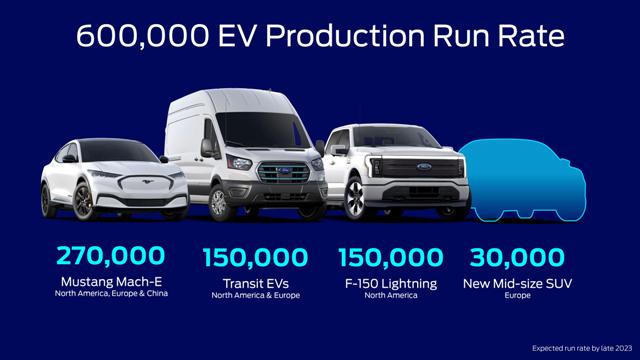
Ford Releases New Battery Capacity Plan, Raw Materials Details To Scale EVs
Ford today announced a series of initiatives for sourcing battery capacity and raw materials that light a clear path to reach its targeted annual run rate of 600,000 electric vehicles by late 2023 and more than 2 million by the end of 2026.
The company detailed its global vehicle portfolio plans supporting these production goals as part of its Ford+ plan. Ford expects a compound annual growth rate for EVs to exceed 90% through 2026, more than double the forecasted global industry growth.
“Ford’s new electric vehicle lineup has generated huge enthusiasm and demand, and now we are putting the industrial system in place to scale quickly,” said Jim Farley, Ford’s president and CEO and president of Ford Model e. “Our Model e team has moved with speed, focus and creativity to secure the battery capacity and raw materials we need to deliver breakthrough EVs for millions of customers.”
Ford plans to invest over $50 billion in EVs through 2026, targeting total company adjusted EBIT margins of 10% and 8% EBIT margins for EVs by 2026.
As Ford creates a new EV supply chain that upholds its commitments to sustainability and human rights, the company continues to plan for more than half its global production to be EVs by 2030 and achieving carbon neutrality globally no later than 2050.
Driving to the 600,000 EV run rate by late 2023
Ford plans to reach a 600,000 global EV run rate by late 2023 with the following EVs:
270,000 Mustang Mach-Es for North America, Europe and China
150,000 F-150 Lightnings for North America
150,000 Transit EVs for North America and Europe
30,000 units of an all-new SUV for Europe, whose run rate will significantly ramp in 2024
Ford is adding lithium iron phosphate (LFP) cell chemistry to its portfolio, alongside its existing nickel cobalt manganese (NCM) chemistry. This creates even more capacity for high-demand products and provides customers many years of operation with minimal range loss. It also reduces the reliance on scarce critical minerals such as nickel and, at current costs, brings a 10 to 15% bill of material savings for Ford versus NCM batteries.
The company confirmed it has secured 100% of the annual battery cell capacity needed – 60 gigawatt hours (GWh) – to support this 600,000 EV run rate by working with leading battery companies around the globe.
Ford announced that Contemporary Amperex Technology Co., Ltd. (CATL) will provide full LFP battery packs for Mustang Mach-E models for North America starting next year as well as F-150 Lightnings in early 2024. Ford’s EV architecture flexibility allows efficient incorporation of CATL’s prismatic LFP cell-to-pack technology, delivering incremental capacity quickly to scale and meet customer demand.
Information Source: Read More
ENERGY | ELECTRIC POWER | NATURAL GAS | AUTOMOTIVE | CLIMATE | RENEWABLE | WIND | TRANSITION | LPG | OIL & GAS | SOLAR | ELECTRIC VEHICLES| BIOMASS | SUSTAINABILITY | OIL PRICE |COMMODITIES | ELECTRIC POWER | NUCLEAR | LNG | REFINED PRODUCTS | SHIPPING|


